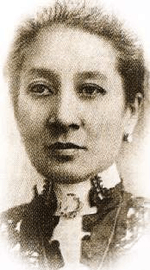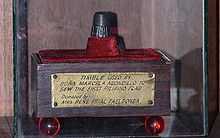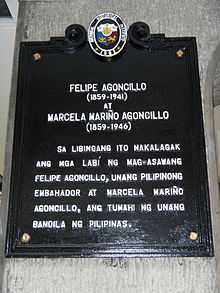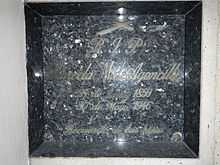Marcela Agoncillo
| Marcela Mariño de Agoncillo | |
|---|---|
 | |
| Born |
Marcela Mariño June 24, 1860 Taal, Batangas, Spanish East Indies |
| Died |
May 30, 1946 (aged 85) Manila, Philippines |
Resting place | La Loma Cemetery |
| Residence | Taal Batangas (ancestral home) and Malate Manila (family) |
| Nationality | Filipino |
| Other names | Doña Marcela, Lola Celay |
| Known for | Her legacy as the principle seamstress of the first and official Philippine flag |
| Spouse(s) | Don Felipe Agoncillo |
| Children | Lorenza, Gregoria, Eugenia, Marcela, Adela and Maria |
| Parents | Francisco Mariño and Eugenia Coronel |
Marcela Mariño de Agoncillo (June 24, 1860 – May 30, 1946),[1][2] also simply known as Marcela Agoncillo, was a Filipina renowned in Philippine history as the principal seamstress of the first and official flag of the Philippines,[3] gaining her the title of Mother of the Philippine Flag.
Agoncillo was a daughter of a rich family in her hometown of Taal, Batangas. Finishing her studies at Santa Catalina College, she acquired her learning in music and feminine crafts. At the age of 30, Agoncillo married Filipino lawyer and jurist Don Felipe Agoncillo and bore him six children. Her marriage led to her important role in Philippine history. When her husband was exiled to Hong Kong during the outbreak of the Philippine Revolution, Agoncillo and the rest of the family joined him and temporarily resided there to avoid the anti-Filipino hostility of some foreign countries. While in Hong Kong, General Emilio Aguinaldo requested her to sew a flag that would represent their country. Agoncillo, her eldest daughter and a friend manually sewed the flag in accordance with General Aguinaldo's design which later became the official flag of the Philippines.
While the flag itself is the perpetual legacy of Agoncillo,[4] she is also commemorated through museums and monuments like the marker in Hong Kong (where her family temporarily sojourned), at her ancestral home in Taal, Batangas which has been turned into a museum,[5] in paintings by notable painters as well as through other visual arts.
Early life
Agoncillo was born on June 24, 1860 in Taal, Batangas, Philippines[6] to Francisco Mariño and Eugenia Coronel. She grew up in their ancestral house in Batangas built in the 1770s by her grandfather, Andres Marino.[7]
As a daughter of a rich and religious family,[8] Agoncillo was referred to in their town as Roselang Hubog which means "a virgin enthroned in the town church". Stories told in the area related that people kept waiting patiently by the church patio for her appearance in the morning to attend mass accompanied either by a maid or an elder relative.[9]
She was sent to a convent after her education in Manila. The convent she was studying in was the Sta. Catalina College of the Dominican nuns, an exclusive school for girls,[10] established in the Walled City of Intramuros where she finished her elementary and secondary education. In college, she learned Spanish, music, the feminine crafts and social graces.[11] She spent her girlhood partly in their hometown and partly in the convent.[12] Accordingly, Agoncillo was skilled in needlework.[2][13][14]
Marriage and family
Agoncillo was married to Don Felipe, a rich Filipino revolutionist and the first Filipino diplomat.[15] They were both thirty and Don Felipe was already a judge when they finally wed. Agoncillo moved from Taal to Manila where they lived together in a two-story house on M.H. del Pillar St., Malate, near the Malate church.[16][17]
Six daughters were born to them: Lorenza ("Enchang"), Gregoria ("Goring"), Eugenia ("Nene"), Marcela ("Celing", named after her mother because they thought she would be their last child), Adela (who died at the age of three) and the youngest, Maria ("Maring", who was their last surviving child and died on July 6, 1995). Most of her daughters became teachers. Gregoria was the first Filipina to graduate from Oxford University.[16] After the graduation of the three elder daughters, they were offered teaching positions. Lorenza was given an appointment to teach in Malate Catholic School.[18] They so immersed themselves in their respective teaching careers that not one of them chose to be married.[16] Marcella Agoncillo cared for all of her daughters until they reached maturity. One of her favorite pieces of advice to them was to "live honestly and well, and to work hard and not depend on family property".[9]
Besides the legal services rendered by Don Felipe to the impoverished,[19] Agoncillo and her daughters observed every Thursday as a day of charity, when a queue of needy people seeking alms would form in the Agoncillo driveway. No one ever left their house empty-handed. Agoncillo would hand them a bag of rice in addition to the money she gave them. This practice lasted until the couple retired.[16]
Living in Hong Kong
After learning of the plans of the Governor-General of the Philippines to deport Don Felipe, he sailed to Yokohama, Japan, staying there only briefly until proceeding to Hong Kong where he joined other Filipino exiles who found asylum when the revolution broke out in 1896. Twenty-two months after the departure of Don Felipe for Hong Kong, Agoncillo and the rest of the family (her last two daughters were not yet born) followed him into exile. They rented a house at 535 Morrison Hill in the Wan Chai district.[20] While in Hong Kong, Agoncillo gave birth to their last child on March 22, 1906.[13]
Felipe, being an exile himself, received any Filipino who came into their house. Thereafter, the place became a sanctuary for other Filipino revolutionary exiles. They initiated meetings in the Agoncillos' residence, especially during the critical months of March and April 1898. Among these folks were Gen. Antonio Luna and Gen. Aguinaldo. Also, Josephine Bracken, Jose Rizal's fiancée, sought refuge in their house when the Spanish authorities threatened to torture her.[10]
Making of the Philippine flag

After the signing of the Pact of Biak-na-Bato on December 14, 1897, General Aguinaldo, after their voluntary exile, visited the Agoncillo residence in Hong Kong.[21] After having met them, Aguinaldo requested that Agoncillo immediately hand-sew a flag according to his design which would embody the national aspirations of all Filipinos. After receiving the request, Agoncillo delegated her eldest daughter, five-year-old Lorenza, and Mrs. Delfina Herbosa de Natividad, Jose Rizal's niece by his sister Lucia, to help her.[22][23][24]
The process took only a short time, but it was difficult. The three worked manually and with the aid of a sewing machine. They had to redo the flag after the rays of the sun were not in the proper direction. Their eyes and hands suffered due to the prolonged work session. Made from fine silk which she bought in Hong Kong,[25] the flag was embroidered in gold and contained stripes of blue and red and a white triangle with the sun and three stars on it.[19][26] The flag was finished in five days[3] and became known as "the sun and the stars flag".[23]

On May 17, 1898, the flag was delivered personally by Agoncillo[3] and was packed among the things Aguinaldo brought back to Manila. This was the flag that was hoisted from the window of Aguinaldo's house in Kawit, Cavite, during the proclamation of Philippine independence on June 12, 1898 accompanied by the Philippine National Anthem Marcha Filipina.[22][27] However, she did not witness either this first public display of the flag or the time when the flag was unfurled during the Malolos Congress because her husband remained in Hong Kong and she remained with him.[28]
In response to the message written by Gen. Aguinaldo, Agoncillo wrote the following statement when she was interviewed:
In the house at 535 Morrison Hill, where I lived with my family, exiled from our country on account of the national cause, I had the good fortune to make the first Philippine flag under the direction of an illust[r]ious leader Gen. Emilio Aguinaldo y Famy...It took me five days to make that National Flag, and when completed, I myself delivered it to Gen. Emilio Aguinaldo before boarding the transport McCullo[ug]h...Gen. Aguinaldo is the best witness who can give the information whether or not that flag was the first to be displayed in Cavite at the beginning of the revolutionary government against the government of Spain in these islands.—Marcela Agoncillo[9]
Post-exile and death
Agoncillo and her daughters stayed in Hong Kong from 1895 to 1906. She took care of their house, which became an asylum. Their funds had run out because of the heavy expenses incurred by Don Felipe for his diplomatic activities in France and in the United States. She once had to sell the children's pinafores[16] and their jewels[10] to support her family and to pay for their voyage back to Manila. The other money was also used to help boost the revolutionary funds. Their support for the revolution made them an impoverished family; however, they gained it back when Don Felipe returned to his profession.[4]
After the fall of the first Philippine Republic and the establishment of the American regime, Agoncillo and her family ended their exile and went back to Manila as soon as they were fetched by Don Felipe after his diplomatic activities abroad had ended.[29] The Agoncillos settled in their family house in Malate. After the death of Don Felipe, Agoncillo's remaining family suffered from starvation due to their meager supply of food, water and other needs. The Japanese conquerors also contributed to their anguish during the period of the Japanese invasion.[9] Taking this all in stride, Marcela remained pragmatic and a source of inspiration. After their house was incinerated during the Japanese occupation, all she said to her remaining daughters was "We will then have to go to Taal."
Though she endured the 1945 Battle of Manila, the health of Agoncillo, who was alternatively called "Doña Marcela" and "Lola Celay" during her old age,[16] was steadily deteriorating. She continued to mourn her deceased husband to such an extent that her daughters found it necessary to hide all his remaining photographs.[30] On May 30, 1946, she quietly died in Manila at the age of 86. Her mortal remains were brought from Taal to Manila and interred alongside her husband in the Catholic cemetery of La Loma according to the wishes of her last will.
Commemoration




Several commemorative figures were created in remembrance of Agoncillo's historic family. On November 27, 1955, a marker was erected by the National Historical Institute of the Philippines and a museum was established in Taal, Batangas in accordance with her last wish and was named Marcela Marino Agoncillo Museum and Monument. The museum is Agoncillo's ancestral house.[7][31] The house-turned-museum permanently exhibits flags and a diorama depicting the sewing of the first flag. A bronze statue of her holding the flag was erected outside the house in its garden.[32] In Hong Kong, a historical marker was created by the Hong Kong Antiquities Council at Morrison Hill Park to commemorate the site where the first Philippine flag was sewn. However, the place where the Agoncillos resided, the location of the Hong Kong Junta, and other locations of historical importance to Filipinos remain unmarked.[33]
Agoncillo's legacy is remembered through the visual arts as well. In 1996, Filipino National Artist Napoleon Abueva created the concrete and marble sculpture Three Women Weaving the Filipino Flag at the UP Diliman to commemorate Agoncillo and the other two women who assisted her in their important task.[34] Renowned Filipino painter Fernando Amorsolo painted the historical sewing and is nationally known as The Making of the Philippine flag.
References
- ↑ "Miriam College Library". Mc.edu.ph. Retrieved 2007-11-21.
- ↑ 2.0 2.1 Mercado, Monina A. (1977), Profiles in Achievement, Philippine Appliance Corp., p. 58, retrieved 2007-11-29.
- ↑ 3.0 3.1 3.2 The Philippine Revolution, Sunday Times Magazine, 1969, p. 15, retrieved 2007-11-29.
- ↑ 4.0 4.1 "146th Birth Anniversary of Doña Marcela Mariño Agoncillo". The Manila Bulletin Online. Mb.com.ph. Retrieved 2007-11-21.
- ↑ Culture Dept. of Education, and Sports, Philippines (1989), Duyan Ng Magiting: The Folk Culture of the Southern Tagalog Region, Dept. of Education, Culture, and Sports, Republic of the Philippines, p. 180, ISBN 978-971-10-1241-0, retrieved 2007-11-28.
- ↑ Zaide, Gregorio F. (1951), Great Events in Philippine History: Patriotic Calendar, M. Colcol, p. 107, retrieved 2007-11-29.
- ↑ 7.0 7.1 "Marcela Agoncillo Historical Landmark". National Historical Institute. Retrieved 2007-11-05.
- ↑ Mercado, Monina A., p. 7 Missing or empty
|title=(help). - ↑ 9.0 9.1 9.2 9.3 "Marcela M. Aconcillo (1860-1946)". Yahoo Geocities. Archived from the original on 2007-10-28. Retrieved 2007-11-04.
- ↑ 10.0 10.1 10.2 del Rosario, Helen O. (June 12, 1998), "Marcela's feat", Philippine Daily Inquirer (The Philippine Daily Inquirer, Inc.): D13, retrieved 2007-11-12
- ↑ "History of Sta. Catalina College". Stacatalinacollege.edu.ph. Retrieved 2007-11-21.
- ↑ Mercado, Monina A. (1977), Profiles in Achievement, Philippine Appliance Corp., p. 61, retrieved 2007-11-29.
- ↑ 13.0 13.1 de Ocampo, Esteban A.; Saulo, Alfredo B. (1977), 's+studies&q=Marcela+Agoncillo's+studies First Filipino Diplomat: Felipe Agoncillo, 1859-1941, National Historical Institute, p. 170, retrieved 2007-11-28.
- ↑ de Ocampo, Esteban A.; Saulo, Alfredo B. (1977), First Filipino Diplomat: Felipe Agoncillo, 1859-1941, National Historical Institute, p. 174, retrieved 2007-12-01.
- ↑ "National Flag Day". Manila Bulletin. Archived from the original on March 17, 2005. Retrieved 2007-11-05.
- ↑ 16.0 16.1 16.2 16.3 16.4 16.5 del Rosario, Helen O. (June 14, 1998), "My most memorable summer with Marcela Agoncillo", Philippine Daily Inquirer (The Philippine Daily Inquirer, Inc.): C7, retrieved 2007-11-11
- ↑ Agoncillo, Marcela Mariño (1981), Reminiscences of the Agoncillo Family, Garcia Pub. Co., p. 167, retrieved 2007-11-28.
- ↑ Reminiscences of the Agoncillo Family, p. 42.
- ↑ 19.0 19.1 Quirino, Carlos (1995), WHO'S WHO: In Philippine History, Metro Manila, Philippines: Tahanan pacific Inc., p. 21, ISBN 971-630-046-8
- ↑ "Selected Families and Individuals". Members.tripod.com. Retrieved 2007-11-05.
- ↑ Saulo, Alfredo B. (1983), Emilio Aguinaldo: Generalissimo and President of the First Philippine ..., Phoenix Pub. House, p. 10, retrieved 2007-12-01.
- ↑ 22.0 22.1 Agoncillo, Teodoro A. (1974), Introduction to Filipino History, Quezon City, Philippines: GAROTECH Publishing, ISBN 971-10-2409-8
- ↑ 23.0 23.1 de Viana, Augusto V. (June 10, 2007). "A haven for Filipino patriots". The Sunday Times. Manilatimes.net. Archived from the original on November 25, 2007. Retrieved 2007-11-04.
- ↑ Hornedo, Florentino H. "The Nation's First Flag". Filipinoheritage.com. Archived from the original on 2007-10-30. Retrieved 2007-11-21.
- ↑ The Philippine Flag, Interview with Marcela Agoncillo, Manila: Philippine Herald, Oct 1929, retrieved 2008-04-22.
- ↑ Zaide, Gregorio F. (1979), The Pageant of Philippine History: Political, Economic, and Socio-cultural, Philippine Education Co., p. 287, retrieved 2007-11-29.
- ↑ The Philippine Revolution, p. 10.
- ↑ Mercado, Monina A. (1977), Profiles in Achievement, Philippine Appliance Corp., p. 60, retrieved 2007-11-29.
- ↑ de Ocampo, Esteban A.; Saulo, Alfredo B. (1977), First Filipino Diplomat: Felipe Agoncillo, 1859-1941, National Historical Institute, p. 181, retrieved 2007-11-29.
- ↑ de Ocampo, Esteban A.; Saulo, Alfredo B. (1977), 's+studies&q=marcela's+death First Filipino Diplomat: Felipe Agoncillo, 1859-1941, National Historical Institute, p. 175, retrieved 2007-11-28.
- ↑ "Batangas City Travel Tips & General Informations". Philtravelcenter.com. Retrieved 2007-11-06.
- ↑ "Marcela Agoncillo Historical Landmark" (pdf). National Historical Institute. Retrieved 2007-11-28.
- ↑ "HK played key role in RP history". Skyscraperss.com. Retrieved 2007-11-05.
- ↑ R. de la Torre, Visitacion. "Napoleon V. Abueva - Father of Modern Sculpture". Filipinoheritage.com. Archived from the original on 2007-10-27. Retrieved 2007-11-05.